

Common Sense Media: Age-Based Media Reviews for Families. Digital Citizenship Curriculum & EdTech Reviews. The Adventures of Kara, Winston and the Smart crew. Our website, like most websites, uses cookies to distinguish you from other users.
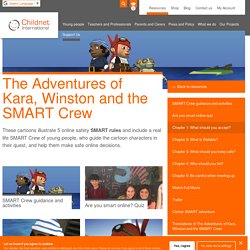
This helps us to improve your experience when you browse our website and also allows us to improve our site. By using cookies, the website is essentially able to ‘remember’ you during a single visit to the site, known as session cookie or for repeat visits, known as persistent cookies. Necessary Cookies Necessary cookies enable core functionality such as page navigation and access to secure areas. The website cannot function properly without these cookies, and can only be disabled by changing your browser preferences. Cyberbullying – let's fight it together. The music throughout the film is a song by Ben Folds called Still Fighting It.

You can listen to it here: JOE: Um … Hi. My name’s Joe. Sinead Laffan - Five, ten, fifteen minutes? Exactly how long does 'development' take? About the webinar Time; there's never enough.

And finding some for your own development can seem impossible. However, short and simple activities can be incredibly revealing and extremely rewarding. Peer observation. In this article I shall look at the basic principles underlying peer observation and its value to institutions and to individual teachers. What is peer observation? Quality control or professional development? How should peer observation be organised? Action research. This article looks at the benefits of action research.
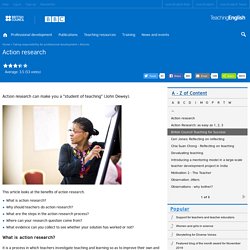
What is action research? Why should teachers do action research? Teaching without a coursebook. What's wrong with using a coursebook?
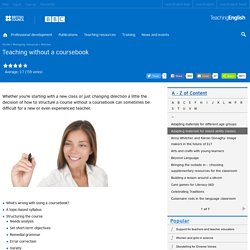
Dogme. Skip to content Dogme is an approach to teaching that argues that teaching should focus on the learner and not be driven by the resources available, including course books.
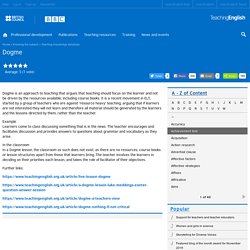
It is a recent movement in ELT, started by a group of teachers who are against 'resource heavy' teaching, arguing that if learners are not interested they will not learn and therefore all material should be generated by the learners and the lessons directed by them, rather than the teacher. ExampleLearners come to class discussing something that is in the news. The teacher encourages and facilitates discussion and provides answers to questions about grammar and vocabulary as they arise. In the classroomIn a Dogme lesson, the classroom as such does not exist, as there are no resources, course books or lesson structures apart from those that learners bring. Further links: Teaching English with minimal resources. Crazy animals and other activities for teaching young learners.
It brings together the experience and expertise of teachers from around the world to provide a range of stimulating and exciting classroom activities for the primary classroom.
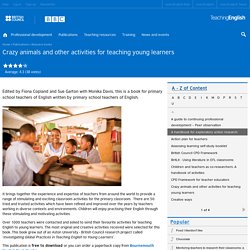
Materials and methodology: How to create resources from nothing. The image in English Language Teaching. Each of these leading experts provide insightful articles and practical ideas for using still and moving images in language education. The list of contributors include Ben Goldstein, Anna Whitcher, Antonia Clare, Paul Driver, Sylvia Karasthati, Paul Dummett, Magdalena Wasilewska, Andreia Zakime, Elena Domínguez Romero, Jelena Bobkina, Candy Fresacher, Tyson Seburn, Chrysa Papalazarou, Magdalena Brzezinska, Emma Louise Pratt, Samantha Lewis, Jean Theuma, and Valéria Benévolo França who are all also members of the Visual Arts Circle, a collective which provides a wide range of resources for you to use and encourages discussion and debate around the use of images in language teaching.
Realia. Here are a few suggestions for activities using realia and to consider why we may want to bring things into the class.

Why use realia in class? The main advantage of using real objects in the classroom is to make the learning experience more memorable for the learner. To give a couple of simple examples, if you are going to teach vocabulary of fruit and vegetables it can be much more affective for students if they can touch, smell and see the objects at the same time as hearing the new word. This would appeal to a wider range of learner styles than a simple flashcard picture of the fruit or vegetable. A second example would be if you are going to teach some functional language for asking for the timetable for a train. Here is a selection of activities involving realia. Tourist information Gather some city/town maps from the tourist information bureau wherever you are. ConcentrationSee these instructions on how to play this game:www.teachingenglish.org.uk/article/concentration Further reading.
C607 Information and Communication WEB ONLY FINAL. A beginner's guide to mobile learning in ELT. In this practical seminar Amy Lightfoot explores the current opportunities for learning English using mobile phones both in and out of the classroom.
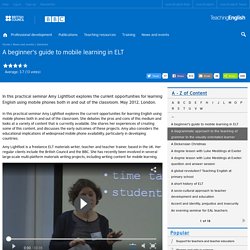
She debates the pros and cons of this medium and looks at a variety of content that is currently available. She shares her experiences of creating some of this content, and discusses the early outcomes of these projects. Amy also considers the educational implications of widespread mobile phone availability, particularly in developing countries. Amy Lightfoot is a freelance ELT materials writer, teacher and teacher trainer, based in the UK. Her regular clients include the British Council and the BBC. Learn English with apps. Mobile pedagogy for English language teaching: A guide for teachers. Video and young learners 1. Effective use of video in the ELT classroom. About the webinar Digital media has seen the availability of online-video reach saturation point, and so too the instances of use it in the classroom.
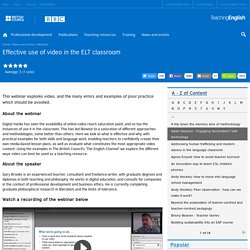
This has led likewise to a saturation of different approaches and methodologies, some better than others. Here we look at what is effective and why, with practical examples for both skills and language work, enabling teachers to confidently create their own media-based lesson plans, as well as evaluate what constitutes the most appropriate video content. Using the examples in The British Council’s ‘The English Channel’ we explore the different ways video can best be used as a teaching resource. About the speaker. Lessonstream.org by Jamie Keddie Home - Lessonstream.org. General English - Video zone. LearnEnglish Teens. Videos for kids. Lessons Worth Sharing.